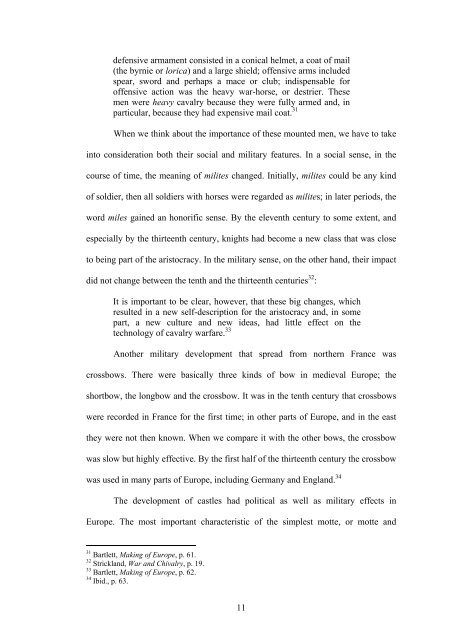I certify that I have read this thesis and have ... - Bilkent University
I certify that I have read this thesis and have ... - Bilkent University
I certify that I have read this thesis and have ... - Bilkent University
Create successful ePaper yourself
Turn your PDF publications into a flip-book with our unique Google optimized e-Paper software.
defensive armament consisted in a conical helmet, a coat of mail<br />
(the byrnie or lorica) <strong>and</strong> a large shield; offensive arms included<br />
spear, sword <strong>and</strong> perhaps a mace or club; indispensable for<br />
offensive action was the heavy war-horse, or destrier. These<br />
men were heavy cavalry because they were fully armed <strong>and</strong>, in<br />
particular, because they had expensive mail coat. 31<br />
When we think about the importance of these mounted men, we <strong>have</strong> to take<br />
into consideration both their social <strong>and</strong> military features. In a social sense, in the<br />
course of time, the meaning of milites changed. Initially, milites could be any kind<br />
of soldier, then all soldiers with horses were regarded as milites; in later periods, the<br />
word miles gained an honorific sense. By the eleventh century to some extent, <strong>and</strong><br />
especially by the thirteenth century, knights had become a new class <strong>that</strong> was close<br />
to being part of the aristocracy. In the military sense, on the other h<strong>and</strong>, their impact<br />
did not change between the tenth <strong>and</strong> the thirteenth centuries 32 :<br />
It is important to be clear, however, <strong>that</strong> these big changes, which<br />
resulted in a new self-description for the aristocracy <strong>and</strong>, in some<br />
part, a new culture <strong>and</strong> new ideas, had little effect on the<br />
technology of cavalry warfare. 33<br />
Another military development <strong>that</strong> sp<strong>read</strong> from northern France was<br />
crossbows. There were basically three kinds of bow in medieval Europe; the<br />
shortbow, the longbow <strong>and</strong> the crossbow. It was in the tenth century <strong>that</strong> crossbows<br />
were recorded in France for the first time; in other parts of Europe, <strong>and</strong> in the east<br />
they were not then known. When we compare it with the other bows, the crossbow<br />
was slow but highly effective. By the first half of the thirteenth century the crossbow<br />
was used in many parts of Europe, including Germany <strong>and</strong> Engl<strong>and</strong>. 34<br />
The development of castles had political as well as military effects in<br />
Europe. The most important characteristic of the simplest motte, or motte <strong>and</strong><br />
31 Bartlett, Making of Europe, p. 61.<br />
32 Strickl<strong>and</strong>, War <strong>and</strong> Chivalry, p. 19.<br />
33 Bartlett, Making of Europe, p. 62.<br />
34 Ibid., p. 63.<br />
11
















